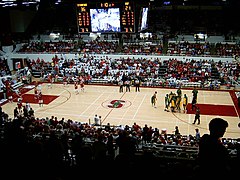Maples Pavilion

|
|
| Full name | Roscoe Maples Pavilion |
|---|---|
| Location | 655 Campus Drive Stanford, California |
| Coordinates | 37°25′47″N 122°09′38″W / 37.4296°N 122.1605°WCoordinates: 37°25′47″N 122°09′38″W / 37.4296°N 122.1605°W |
| Owner | Stanford University |
| Operator | Stanford University |
| Capacity | Basketball: 7,233 |
| Construction | |
| Broke ground | 1967 |
| Opened | January 3, 1969 48 years ago |
| Renovated | March 2004 |
| Construction cost |
$3.24 Million ($21.2 million in 2016 dollars) |
| Architect | John Carl Warnecke |
| Tenants | |
| Stanford Cardinal (1969–present) | |
Maples Pavilion is a 7,392-seat multi-purpose arena on the campus of Stanford University in Stanford, California. Opened 48 years ago in early 1969, Maples underwent a $30 million renovation in March 2004 and reopened ahead of schedule, in time for conference play that December. It was named after its principal donor, Roscoe Maples, a member of the class of 1904. Prior to 1969, Stanford played at the Old Pavilion, opened in 1922.
Maples is home to multiple Stanford Cardinal athletics teams, including men's and women's basketball and women's volleyball. The raucous student section that roots for the men's basketball team is called the "6th Man" and it is located in several rows along courtside.
Prior to the renovation, the original floor at Maples had a very springy feel to it. Designed by Stanford graduate John Carl Warnecke (1919–2010), it was installed when the Pavilion opened in 1969. Nine inches (23 cm) of crosshatched wood and air was supposed to create a coil-spring effect preventing injuries, but often had the opposite effect. It caused a "Missed Stair Effect," a phenomenon that occurs when the body senses where the floor should be upon landing after a jump. With the springy feeling of the floor, often the level would be different from when the player jumped, causing a strange sensation throughout the body.
On October 14, 2010, the Dalai Lama advocated a secular approach to compassion to a standing room only crowd.
Upon his death in 1963, Roscoe W. Maples bequeathed most of his $2 million estate to the university. A member of the class of 1904, he left school before graduating to support his parents, and was later successful in the lumber business in Oregon.
...
Wikipedia
